The first luxury SUV? It wasn’t the Range Rover
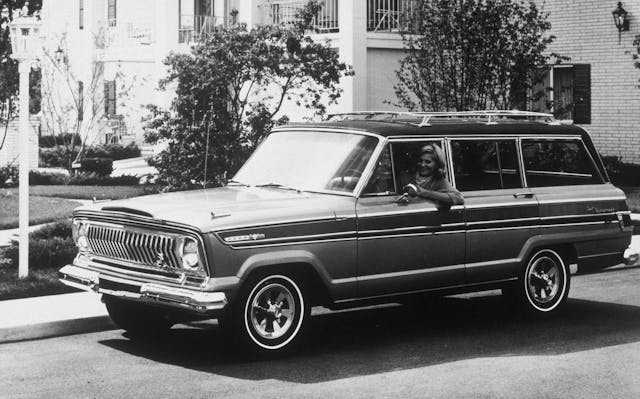
Escalade, Navigator, Cullinan, Bentayga, Urus, Levante, Range Rover, G-Wagen, Cayenne, DBX, X7, and Q8. In an age in which every automaker sells a luxury SUV, it’s easy to forget that such a vehicle didn’t always exist. No, the 1970 Land Rover Range Rover didn’t pioneer this trail; that honor falls to the 1966 Jeep Super Wagoneer, a vehicle whose story starts much earlier.
As World War II came to an end, Willys-Overland president Charles Sorensen, an ex-Ford executive, realized the company’s greatest chances of success in the new car market lay in its Jeep, not in its poor-selling line of cars. While the market for Jeeps was small, its wartime fame held a promise of profitability; development costs for new Jeep models would be minimal and competition negligible.
So Willys abandoned a planned Jeep-based car named the 6/70, designed by Milwaukee-based industrial designer Brooks Stevens, and instructed Stevens to create a line of civilian Jeeps. However, there was a catch. The vehicles had to be designed with exterior panels that could be stamped by appliance factories, since traditional body manufacturers received too much business from larger automakers to bother with Willys.

The result, the Jeep Station Wagon, arrived for 1946, an all-steel station wagon with exterior panels that evoked the appearance of the wood body panels commonly found on station wagons. Built on a heavily-modified prewar Willys Americar chassis, the two-door 1946 Jeep Station Wagon seated seven thanks to its two bench seats and a sideways-facing third-row seat clad in stylish imitation leather. Able to carry up to 96 cubic feet of lifestyle debris, the wagon packed a prewar Willys 134 cubic-inch (2.2-liter) L-head four-cylinder engine rated at 63 hp with a three-speed manual transmission.

This being a Jeep, you might expect the Station Wagon to have four-wheel drive, but you’d be wrong. Not until 1949 did Willys built one with four-wheel-drive, unintentionally creating the first modern SUV. It wasn’t divine inspiration that led to this model, either; it was a special order from the U.S. Army in 1948. Other upgrades included a new line of “Hurricane” four- and six-cylinder engines, which improved the wagon’s anemic performance. The model would remain mostly unchanged as Willys-Overland was bought by Kaiser Motors Corporation in 1953 to shore up Kaiser’s crumbling market share. By the decade’s end, the Jeep Station Wagon was battling newer, truck-based 4×4 competitors like the Chevrolet/GMC Suburban, International Harvester Travelall, and the Dodge Power Wagon.
Once again, Jeep turned to Brooks Stevens to pen a replacement in 1959, investing $20 million in its development.
Stevens dubbed his prototype the Malibu, which debuted in 1962 as the Jeep Wagoneer. Marketers portrayed the Wagoneer as something new, which it truly was. “The Wagoneer is not a converted passenger car with a tailgate thrown in,” read the brochure, “nor a modified truck with windows—the all-new ‘Jeep’ Wagoneer was conceived and designed as a wagon.”

Built on the SJ platform, the new Wagoneer was available with two- or four-wheel drive and either two doors or four. With a 110-inch wheelbase and 183.6-inch length, the Wagoneer was nearly eight inches longer than the Station Wagon it replaced. It could carry six passengers and was the first Jeep that shared none of its design with its flat-fender siblings. The Wagoneer’s crisp, modern lines were capped by a large keystone-shaped grille flanked by round vents and headlights. It was distinctive, even stylish—something that couldn’t be said of any Jeep before it.
The Wagoneer’s engineering was advanced for its time. It was the first four-wheel-drive wagon to offer an independent front suspension (standard on 4x2s, optional on 4x4s) and an automatic transmission built by Borg-Warner. Power came from the only overhead-cam engine built by an American automaker, a “Tornado” 230-cu-in (3.8-liter) six-cylinder rated at 140 hp and 210 lb-ft. A three-speed manual transmission came standard.
As you’d expect, base models wore fairly plain upholstery and rubber floor mats (and had a roll-down tailgate window). Fancier Deluxe models, later known as Customs, came with carpeting, upgraded upholstery and door trim, and, on four-wheel-drive models, a compass. Options included a front-mounted winch, push-button AM radio, glove box light, electric clock, dual-speed windshield wipers, power steering, power brakes, overdrive, heater and defroster, seat belts, right-side mirror, snow plow, electrically operated tailgate window, and upgraded trim. Prices started at $2546 for a two-door 4×2.
For 1964, Jeep expanded the options list to include air conditioning. In 1965 an American-Motors-made 250-hp “Vigilante” 327-cu-in (5.3-liter) V-8 arrived, paired with a General Motors Turbo Hydra-Matic automatic transmission. A mid-year facelift saw the Wagoneer’s keystone grille replaced with a full-width chrome grille. The new look visually distinguished the Wagoneer from other SJ-platform models, like the Gladiator pickup. Jeep also added a new standard 145-hp, 232-cu-in (3.8-liter) OHV six-cylinder engine courtesy of AMC, and an optional low range for 4x4s with an automatic transmission.
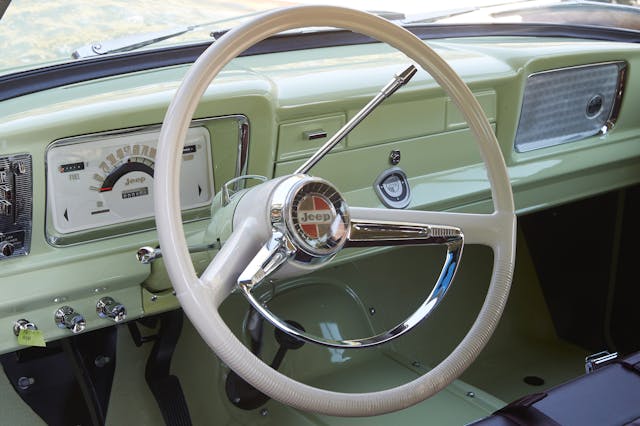
The real change came in 1966, when the Wagoneer got a new, top-of-the-line model: the Super Wagoneer. The idea of a wagon that was both plush and utilitarian was novel, although the concept was nothing new for Jeep. Willys had offered a premium version of the Station Wagon in 1948, the Station Sedan, powered by a Willys six-cylinder engine and boasting upgraded interior trim. It never caught on with buyers, though, who saw station wagons as no-frills haulers. By 1950, the Station Sedan was gone.
So Jeep tried once again, piling on every imaginable extravagance. The Super Wagoneer came dressed with a full-width grille, a padded vinyl roof with a chrome roof-rack, tinted windows, tri-tone body striping, whitewall tires with full wheel hubcaps, and tinted windows. Inside, drivers were treated to bucket seats and a center console, seven-position tilt steering wheel, air conditioning, full carpeting, power brakes, power steering, a power tailgate window, and an AM pushbutton radio. Jeep’s 270-ho, 327-cu-in “Vigilante” four-barrel V-8 engine and console-shifted TH400 Turbo Hydra-Matic automatic transmission were standard. If none of this sounds very luxurious, keep in mind that expectations were much lower in an era when almost everything that came on a car—even side-view mirrors—was optional. While Cadillacs and Lincolns had this level of standard equipment, a laundry list of features this luxurious was unheard of in a sport utility vehicle.
The base price? $5943 (or $48,422 today), $2163 higher than a Wagoneer Custom four-door 4×4, and several hundred dollars higher than a Cadillac DeVille.
The Super Wagoneer did not prove a huge seller and only lasted through 1968. Despite its fate, the notion of taking the Wagoneer upmarket never died, even when AMC purchased Kaiser Jeep Corporation in 1970. AMC began upgrading the Wagoneer with more powerful V-8 engines and added Quadra-Trac four-wheel drive in 1972 so that drivers no longer had to manually engage the transfer case and locking hubs. Front-disc brakes followed two years later. All of this set the stage for the return of the Super Wagoneer in 1978 under the Limited nameplate.
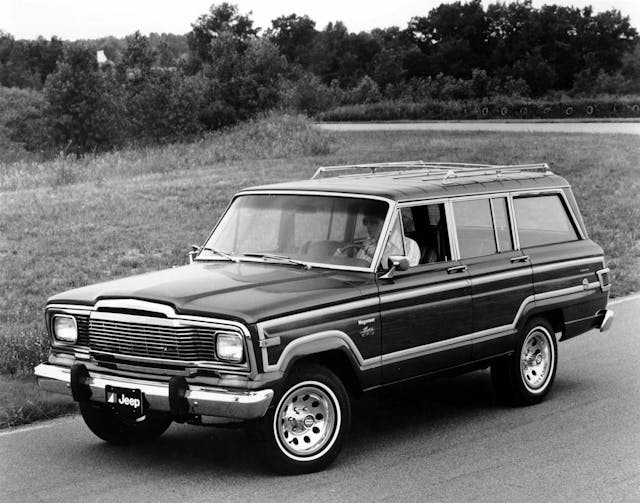
Despite the name change, the idea was much the same: lots of standard luxury gear, a V-8, Quadra-Trac, an automatic transmission, power-adjustable bucket seats, leather upholstery and steering wheel, power steering, power brakes, plush carpet, cruise control, power tailgate window, disc brakes, and the requisite woodgrain side panel trim.
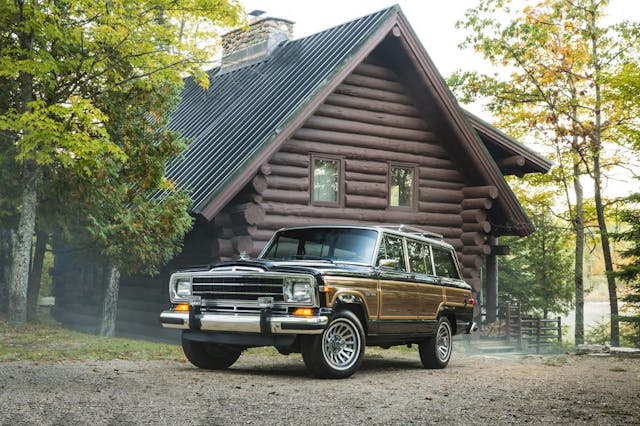
This time, the luxe Wagoneer proved a success and remained a part of the lineup even once the Wagoneer was downsized onto AMC’s new XJ platform. The old Wagoneer was renamed the Grand Wagoneer for 1985 and produced through 1991, wearing the same body panels it did in 1962.
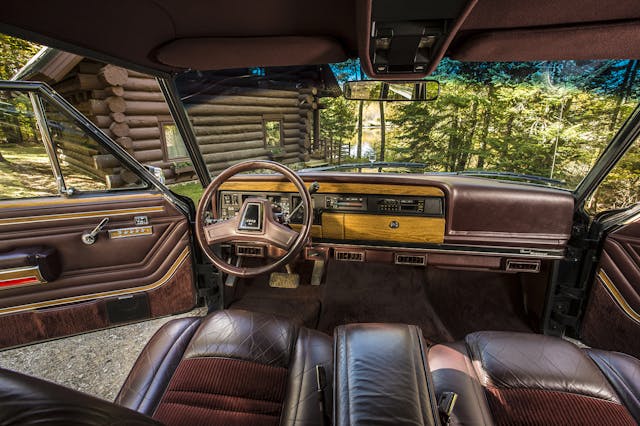
Now, for 2021, the Wagoneer returns as a standard-wheelbase Wagoneer. An extended-length Grand Wagoneer joins the party as well as the first three-row Jeep since the Commander disappeared a decade ago. Reclaiming its position as the poshest Jeep SUV, the newest Wagoneer continues the tradition established by the Super Wagoneer in 1966.



my previous comment was gone. Why?